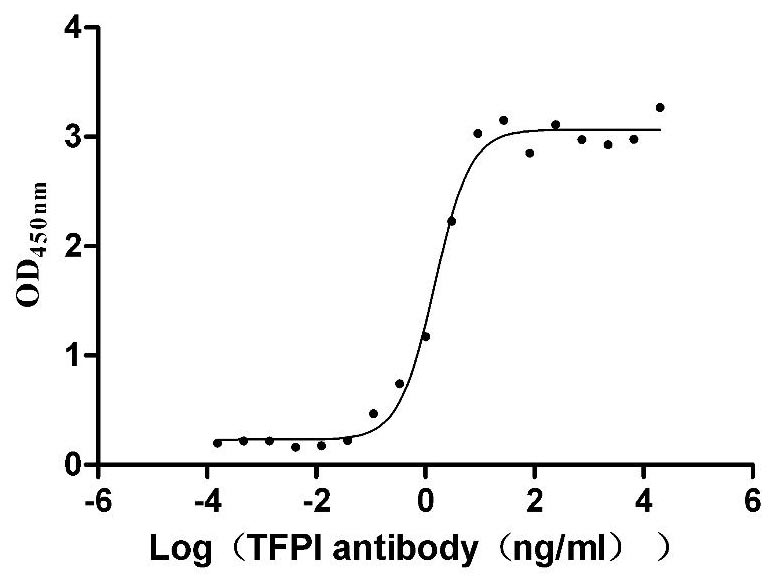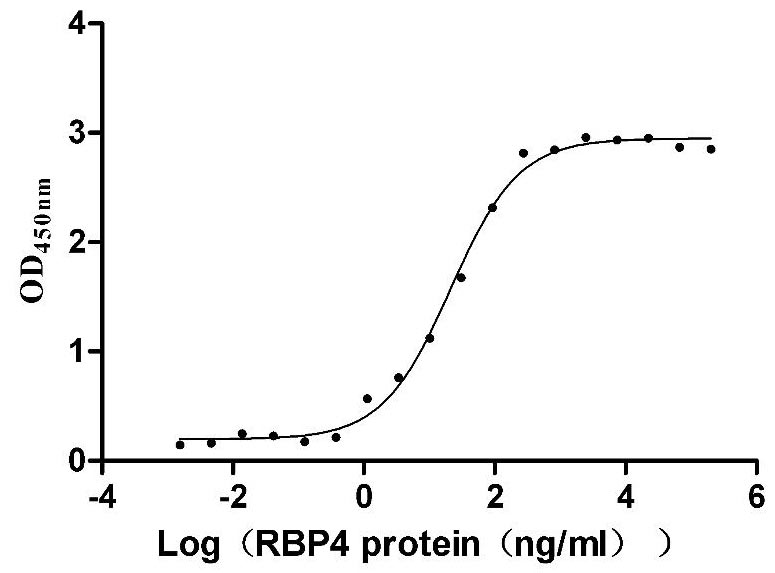Recombinant Human Neural Wiskott-Aldrich syndrome protein (WASL), partial
-
中文名称:人WASL重组蛋白
-
货号:CSB-YP025973HU
-
规格:
-
来源:Yeast
-
其他:
-
中文名称:人WASL重组蛋白
-
货号:CSB-EP025973HU
-
规格:
-
来源:E.coli
-
其他:
-
中文名称:人WASL重组蛋白
-
货号:CSB-EP025973HU-B
-
规格:
-
来源:E.coli
-
共轭:Avi-tag Biotinylated
E. coli biotin ligase (BirA) is highly specific in covalently attaching biotin to the 15 amino acid AviTag peptide. This recombinant protein was biotinylated in vivo by AviTag-BirA technology, which method is BriA catalyzes amide linkage between the biotin and the specific lysine of the AviTag.
-
其他:
-
中文名称:人WASL重组蛋白
-
货号:CSB-BP025973HU
-
规格:
-
来源:Baculovirus
-
其他:
-
中文名称:人WASL重组蛋白
-
货号:CSB-MP025973HU
-
规格:
-
来源:Mammalian cell
-
其他:
产品详情
-
纯度:>85% (SDS-PAGE)
-
基因名:
-
Uniprot No.:
-
别名:DKFZp779G0847; MGC48327; N-WASP; Neural Wiskott Aldrich syndrome protein; Neural Wiskott-Aldrich syndrome protein; NWASP; Wasl; WASL_HUMAN; WASPB; Wiskott Aldrich syndrome gene like; Wiskott Aldrich syndrome gene like protein; Wiskott Aldrich syndrome like; WiskottAldrich syndrome like
-
种属:Homo sapiens (Human)
-
蛋白长度:Partial
-
蛋白标签:Tag type will be determined during the manufacturing process.
The tag type will be determined during production process. If you have specified tag type, please tell us and we will develop the specified tag preferentially. -
产品提供形式:Lyophilized powder
Note: We will preferentially ship the format that we have in stock, however, if you have any special requirement for the format, please remark your requirement when placing the order, we will prepare according to your demand. -
复溶:We recommend that this vial be briefly centrifuged prior to opening to bring the contents to the bottom. Please reconstitute protein in deionized sterile water to a concentration of 0.1-1.0 mg/mL.We recommend to add 5-50% of glycerol (final concentration) and aliquot for long-term storage at -20℃/-80℃. Our default final concentration of glycerol is 50%. Customers could use it as reference.
-
储存条件:Store at -20°C/-80°C upon receipt, aliquoting is necessary for mutiple use. Avoid repeated freeze-thaw cycles.
-
保质期:The shelf life is related to many factors, storage state, buffer ingredients, storage temperature and the stability of the protein itself.
Generally, the shelf life of liquid form is 6 months at -20°C/-80°C. The shelf life of lyophilized form is 12 months at -20°C/-80°C. -
货期:Delivery time may differ from different purchasing way or location, please kindly consult your local distributors for specific delivery time.Note: All of our proteins are default shipped with normal blue ice packs, if you request to ship with dry ice, please communicate with us in advance and extra fees will be charged.
-
注意事项:Repeated freezing and thawing is not recommended. Store working aliquots at 4°C for up to one week.
-
Datasheet :Please contact us to get it.
相关产品
靶点详情
-
功能:Regulates actin polymerization by stimulating the actin-nucleating activity of the Arp2/3 complex. Involved in various processes, such as mitosis and cytokinesis, via its role in the regulation of actin polymerization. Together with CDC42, involved in the extension and maintenance of the formation of thin, actin-rich surface projections called filopodia. In addition to its role in the cytoplasm, also plays a role in the nucleus by regulating gene transcription, probably by promoting nuclear actin polymerization. Binds to HSF1/HSTF1 and forms a complex on heat shock promoter elements (HSE) that negatively regulates HSP90 expression. Plays a role in dendrite spine morphogenesis. Decreasing levels of DNMBP (using antisense RNA) alters apical junction morphology in cultured enterocytes, junctions curve instead of being nearly linear.
-
基因功能参考文献:
- N-WASP positively regulates demarcation membrane system development and proplatelet formation, and the Src family kinases in association with CDC42 regulate proplatelet formation through N-WASP PMID: 27685868
- By using VCA nanobodiess, study shows the influence of N-WASps VCA domain in invadopodium formation and extracellular matrix degradation PMID: 28938008
- Recruitment of Paxillin, Cdc42 and N-WASP is necessary for cell adhesion, migration and invasion induced by Estradiol in breast cancer cells. PMID: 27095481
- This suggests that TOCA1 binding to Cdc42 is an early step in the Cdc42-dependent pathways that govern actin dynamics, and the differential binding affinities of the effectors facilitate a handover from TOCA1 to N-WASP, which can then drive recruitment of the actin-modifying machinery. PMID: 27129201
- the Cdc42/Nwasp/stress fibers/YAP signal pathway may potentially play an important role in regulating podocyte apoptosis. Maintaining necessary Cdc42 would be one potent way to prevent proteinuria kidney diseases. PMID: 26986510
- RTVP-1 regulates glioma cell spreading, migration and invasion and that these effects are mediated via interaction with N-WASP and by interfering with the inhibitory effect of hnRNPK on the function of this protein. PMID: 26305187
- Nck was the most potent activator of N-WASP-driven actin assembly. PMID: 26554011
- our results reveal a novel role for N-WASP in remodeling EC junctions, which is critical for monolayer integrity and function. PMID: 26070569
- These results support a role for N-WASP in amphiphysin-2-dependent nuclear positioning and triad organization and in centronuclear myopathy and myotonic dystrophy pathophysiology. PMID: 25262827
- PC1 modulates actin cytoskeleton rearrangements and directional cell migration through the Pacsin 2/N-Wasp complex. PMID: 24385601
- Our observations suggest that ITSN1 is an important general regulator of Cdc42-, Nck- and N-WASP-dependent actin polymerisation PMID: 24284073
- c-Src and NWASP play key roles in mediating the molecular pathogenesis of low oxygen-induced accelerated brain invasion by gliomas. PMID: 24069415
- A gain-of-function approach for miR-142-3p revealed a down-regulation of N-Wasp expression accompanied by a decrease of mycobacteria intake, while a loss-of-function approach yielded the reciprocal increase of the phagocytosis process. PMID: 23760605
- endocytosis by endothelial cells may represent a means of traversal of the blood vessel wall by yeast during disseminated candidiasis, and N-WASP may play a key role in the process. PMID: 23690407
- N-WASP has a crucial proinvasive role in driving Arp2/3 complex-mediated actin assembly in cooperation with FAK at invasive cell edges, but WRC depletion can promote 3D cell motility. PMID: 23273897
- NWASP activation by mycolactone underpins Buruli ulcer formation via modulation of the actin cytoskeleton. PMID: 23549080
- Neural Wiskott-Aldrich syndrome protein (N-WASP)-mediated p120-catenin interaction with Arp2-Actin complex stabilizes endothelial adherens junctions. PMID: 23212915
- Study portrays a role for Claudin-5 in cell motility involving the N-WASP signalling cascade indicating a possible role for Claudin-5 in the metastasis of human breast cancer. PMID: 22559840
- results indicate that by mediating intensive F-actin accumulation at the sites of cell infiltration, WAVE2, N-WASP, and Mena are crucial for PI3K-dependent cell invasion induced by PDGF PMID: 21769917
- N-WASP assists in the recruitment and localization of Tuba to the cell junction. PMID: 21677511
- Perturbation of N-WASP-CK2 complex function showed that N-WASP controls the presence of F-actin at clathrin-coated structures. N-WASP-CK2 complex integrates in a single circuit different activities contributing to CME. PMID: 21610097
- N-WASP plays a role in efficient assembly of kinetochores and attachment of microtubules to chromosomes, which is essential for accurate chromosome congression and segregation PMID: 21533546
- N-WASP-WIRE serves as an integrator that couples actin nucleation with the subsequent steps of filament stabilization and organization necessary for zonula adherens integrity. PMID: 21785420
- Recruitment of FAK and N-WASP is necessary for cell migration and invasion induced by 17beta-estradiol in breast cancer cells. PMID: 20880986
- CFL1 and N-WASP may play an important role in the tumorigenesis of ESCC, and to be the candidate novel biomarkers for the diagnosis and prognosis of esophageal squamous cell carcinoma. PMID: 20095995
- Cdc42 regulates the activity of IRSp53 by regulating the IRSp53-WIRE interaction as well as localization of the complex to plasma membrane to generate filopodia. PMID: 20678498
- Cdc42 may influence endocytic membrane trafficking by regulating the formation and activity of the Toca-1/N-WASP complex. PMID: 20730103
- Arg promotes actin-based protrusions in response to extracellular stimuli through phosphorylation of and physical interactions with N-WASp. PMID: 20146487
- nuclear localization of N-WASP modulates Src kinase activity by regulating HSP90 expression PMID: 12871950
- Expression of the WA fragment of N-WASP to block associated actin polymerization also inhibited C. parvum invasion. PMID: 15102814
- Erk phosphorylation liberates the SH3 domain of cortactin from intramolecular interactions with proline-rich regions, causing it to synergize with WASP and N-WASP in activating the Arp2/3 complex PMID: 15169891
- The cooperative actions of two distinct Cdc42 effectors, the N-WASP-WIP complex and Toca-1, are required for Cdc42-induced actin assembly. PMID: 15260990
- NF2 tumor suppressor Merlin and the ERM proteins interact with N-WASP and regulate its actin polymerization function PMID: 15699051
- Nef interferes with maturation of stimulatory T-lymphocyte contacts by modulation of N-Wasp activity PMID: 16687395
- We demonstrate that the interaction of N-WASP with the PSF-NonO complex can couple N-WASP with RNA polymerase II to regulate transcription. PMID: 16767080
- a vesicle trafficking regulator Toca-1 regulates different aspects of neuronal morphology from N-WASP PMID: 16885158
- CR16 and N-WASP are suggested to play important roles in spermatogenesis PMID: 17573773
- N-WASP, a member of the N-WASP family may act as a tumour progression suppressor in human breast cancer and may therefore have significant clinical value in this condition. PMID: 17985201
- These data constitute evidence that Toca-1 is required for N-WASP-mediated actin polymerization by Shigella flexneri in vivo. PMID: 18191793
- of N-WASP and, subsequently, the Arp2/3 complex appears to be an important molecular signal for regulating spines and synapses PMID: 18430734
- Wiskostatin induced defective cytokinesis does not occur through the inhibition of the N-WASP pathway. PMID: 18667055
- Compared with controls, neuronal Wiskott-Aldrich syndrome protein expression in brains of intractable epilepsy patients was significantly higher. PMID: 18708039
- the Toca-1-N-WASP complex can link filopodial formation to endocytosis PMID: 19213734
- the exchange rate of N-WASP controls the rate of ARP2/3-complex-dependent actin-based motility by regulating the extent of actin polymerization by antagonizing filament capping PMID: 19262673
显示更多
收起更多
-
亚细胞定位:Cytoplasm, cytoskeleton. Nucleus. Cytoplasm.
-
数据库链接:
HGNC: 12735
OMIM: 605056
KEGG: hsa:8976
STRING: 9606.ENSP00000223023
UniGene: Hs.143728
Most popular with customers
-
Recombinant Human Tissue factor pathway inhibitor (TFPI), partial (Active)
Express system: Mammalian cell
Species: Homo sapiens (Human)
-
Recombinant Human Intestinal-type alkaline phosphatase (ALPI) (Active)
Express system: Mammalian cell
Species: Homo sapiens (Human)
-
Recombinant Mouse Transthyretin (Ttr) (Active)
Express system: Mammalian cell
Species: Mus musculus (Mouse)
-
Recombinant Macaca fascicularis Claudin (CLDN18)-VLPs (Active)
Express system: Mammalian cell
Species: Macaca fascicularis (Crab-eating macaque) (Cynomolgus monkey)
-
Recombinant Human Claudin-4 (CLDN4)-VLPs (Active)
Express system: Mammalian cell
Species: Homo sapiens (Human)
-
Recombinant Human IL12B&IL12A Heterodimer Protein (Active)
Express system: Mammalian cell
Species: Homo sapiens (Human)
-
Recombinant Mouse CUB domain-containing protein 1 (Cdcp1), partial (Active)
Express system: Mammalian cell
Species: Mus musculus (Mouse)
-
Recombinant Macaca fascicularis Gastric inhibitory polypeptide receptor (GIPR), partial (Active)
Express system: yeast
Species: Macaca fascicularis (Crab-eating macaque) (Cynomolgus monkey)




















